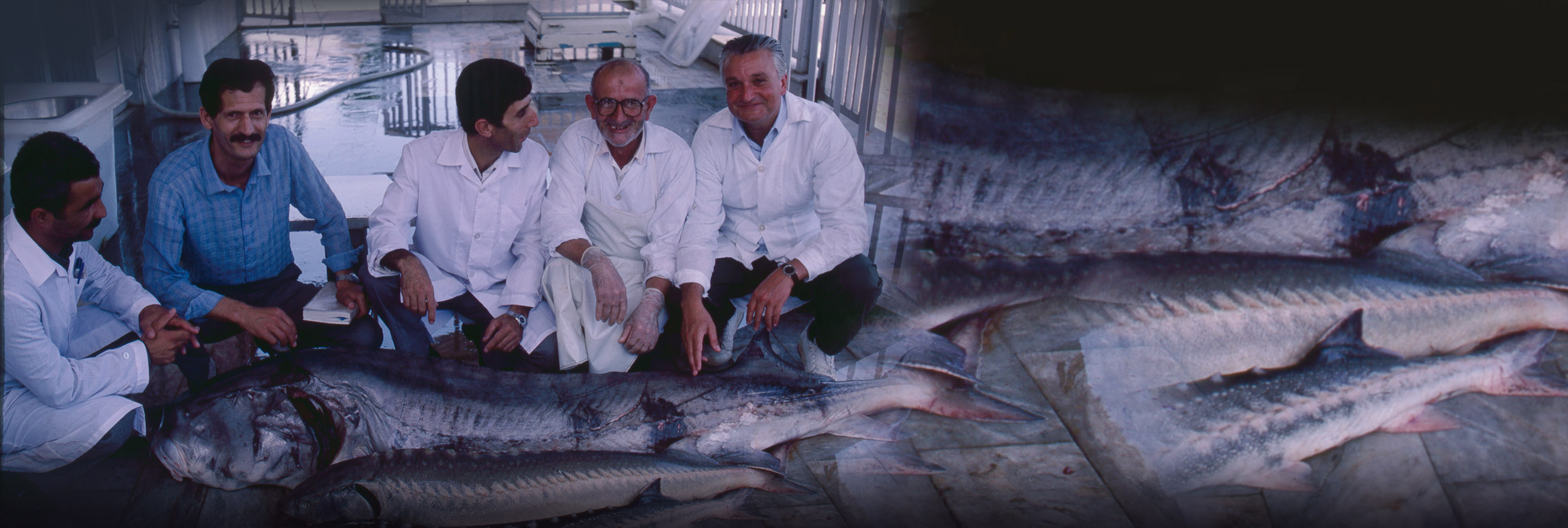No products
- Caviar Guide
- Caviar basics
- What is caviar?
- What is a good caviar?
- How to enjoy caviar?
- How to serve and pair caviar
- What are the types' differences?
- Caviar nutritional values
- Recipes with caviar
- Caviar production
- Caviar producers
- Challenges of sturgeon farming
- Caviar processing steps
- Kaviari expertise - Caviar selection
- Kaviari expertise - Caviar ageing / maturation
- Kaviari expertise - Caviar traceability
- All about sturgeons
- Sturgeons' main types
- Why is sturgeon endangered?
- A protected specie
Sturgeons' main types

The Acipenser... what a fish! The sturgeon is a bony fish of the Acipenseriformes family. It's an old-fashioned fish, a real living fossil! The sturgeon is indeed one of the last representatives of the Teleosteens, or fish with a complete skeleton, just like the very first fish that have inhabited the seas.
Its varieties are distinguished by the four tactile extensions of the dermis, just under the mouth, which serve to aspirate its prey.
The sturgeon has been living in low salted waters for more than 200 million years! It is a large migratory fish that, like salmon, lives at sea and rises the rivers to lay its eggs. Sturgeons can reach 100 years old; No wonder their puberty lasts 8 to 20 years, depending on the variety.
There are at least 26 recorded varieties of sturgeon in the world. Five species inhabit the Caspian Sea but only 3 were worthy to produce the famous wild caviar (Sevruga, Oscietra, Beluga). Those ones used to produce 90% of the world's production of wild caviar. Today, only 9 species have been selected for their adaptability in fresh water. These sturgeons are raised in ponds or lakes. Each species corresponds to a specific egg nature. The resulting caviars are thus themselves different.
The Beluga (Huso Huso) is the largest sturgeon, and the only carnivorous. It is so rare that one rarely catches more than 100 per year (the time of the wild caviar). Extremely powerful and wild, this wide-mouthed traveler is always on the move, looking for his prey. The beluga can reach more than 6 meters and weigh more than one tonne. It is the most threatened species in the wild. Eggs can represent up to 25% of its weight! In aquaculture, it is a very difficult fish to raise, it requires professionals' know-how to work on its adaptation and its maturity. Nowadays very few farms raise Belugas because it takes at least 15 years for the fish to give their first eggs.

The Asetra or Osciètre (Acipenser Gueldanstaedtii or Acipenser Persicus) is the medium-sized sturgeon. This omnivorous fish has hard scales spread throughout the body and its color goes from dark gray to brown. The Asetra can reaches meters long and weighs up to 200kg, but the average is 1.2 meters and 20 to 80kg. It might be the most mysterious and interesting sturgeon as its grains can shows big differences in term of size, taste and color. It can live up to 80 years old. Its sexual maturity is around 12 - 15 years old in the wild, while in farms and warmer water, females can produce eggs from 8-10 years old.

The Sevruga (Acipenser Stellatus) is the small sturgeon with the trumpet's nose, the one whose bony diamonds are the most visible on the flanks. It has characteristic hard scales, the shape of which resembles small stars, that is why "the starred sturgeon". Never bigger than 1.5 meters long, it rarely exceeds 25kg. Like the Oscieter, the Sevruga is omnivorous and eat seaweed and small crustaceans. The female Sevruga begins to produce eggs between 7 and 10 years, which is earlier than other sturgeons. At this age, the eggs constitute 10 to 12% of its weight. Eggs reach the peak of their quality when the fish reaches 20 years old.
The Schrencki (Acipenser Schrencki) is a sturgeon that lives in the wild on the Amur River, and is raised in China. It is a fish that can measure up to 2 meters long and weigh up to 100kg but the average is 1.2 meters and 20 to 80kg. A legend tells that in 1993, a sturgeon of 5.20 meters has been fished in the Amur River, with a size of a minibus!

The Baeri (Acipenser Baeri) is a sturgeon native of Siberia (Sturgeon of Siberia). It reaches up to 3 meters long in natural environment. Otherwise, its size varies between 0.5 and 1 meter long and its average weight rarely exceeds 10kg. It is the species that is mainly raised in France. Its strain was imported into fish farming in 1989 and is today one of the most used species for breeding. We now find Baeri caviar from all over the world (France, Italy, Germany, Finland, Uruguay, China ...). It takes at least 7 years for the female to mature and give her first eggs.

White Sturgeon (Acipenser Transmontanus) is a sturgeon that migrates between the major rivers of the American West Coast and the Pacific Ocean (San Francisco Bay or Vancouver). Im the wild, it can weigh up to 200 kg and only exceptionally exceeds 4 meters long. In aquaculture, its average size is 1.5 meters for a weight varying between 20 and 80 kg. It is the specie we find the most in California farms. But we find it also in Europe, mainly in Italy. Its name "white sturgeon" is due to its white scales along its body ,not the color of its grains!
